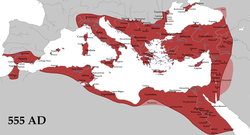Saylor.org's Ancient Civilizations of the World/The Byzantine Empire
The Byzantine Empire: Overview
[edit | edit source]
The Byzantine Empire (or Byzantium) was the Roman Empire during Late Antiquity and the Middle Ages, centered on the capital of Constantinople. The state is also referred to as the Eastern Roman Empire, primarily in the context of Late Antiquity, and especially while the Western Roman Empire was still maintained in Italy. Both "Byzantine Empire" and "Eastern Roman Empire" are historiographical terms applied in later centuries. Throughout its existence the state was known simply as the Roman Empire or Romania and was the direct continuation of the Roman State, maintaining Roman state traditions. As the Western Roman Empire fragmented and collapsed in the 5th century, the Eastern Roman Empire continued to thrive, existing for more than a thousand years until 1453. During most of its existence, the empire was the most powerful economic, cultural, and military force in Europe.
As the distinction between "Roman " and "Byzantine" is a modern convention, it is not possible to assign a single date of transition. However, there are several important dates. In 285, Emperor Diocletian (r. 284–305) divided the Roman Empire's administration into eastern and western halves. In 324, Emperor Constantine I (r. 306–337) transferred the eastern capital from Nicomedia in Asia Minor to Byzantium in Europe on the Bosphorus, which became Constantinople, the "City of Constantine" or alternatively "New Rome". A final period of transition began during the later reign of Emperor Heraclius (r. 610–641) when he entirely transformed the empire by reforming the army and administration by introducing themes and by changing the official language of the Empire from Latin to Greek. The transition was also facilitated by the fact that in Heraclius' and his immediate successors' time, largely non-Greek territories in the Middle East and North Africa were lost to the emerging Arab Caliphate, and the Empire was left with the predominantly Greek-speaking core. As such Byzantium is today distinguished from ancient Rome proper insofar as it was oriented towards Greek culture, characterised by Orthodox Christianity as the state church after 380, rather than Roman polytheism, and was predominantly Greek-speaking rather than Latin-speaking.

During the reign of Justinian I (r. 527–565), the empire reconquered much of the western Mediterranean coast, including north Africa, Italy, and Rome, which the empire held onto for two more centuries. During the mid 6th century, the Plague of Justinian wiped out roughly a third of the empire's population, creating major military and financial difficulties. Nevertheless, during the reign of Emperor Maurice (r. 582–602), the empire's eastern frontier was expanded and its northern frontier stabilised. However, Maurice's assassination in 602 caused a two decade-long war with Sassanid Persia which, despite Emperor Heraclius's spectacular victory, exhausted the empire's manpower and resources, contributing to major defeats and territorial losses during the Byzantine–Arab Wars in the 7th century. Despite these setbacks, the empire recovered during the 10th century under the Macedonian dynasty, rising again to become the most powerful state in Europe and the Mediterranean.
After 1071, however, much of Asia Minor, the Empire's heartland, was lost to the Seljuk Turks. The Komnenian restoration regained some ground and briefly reestablished dominance in the 12th century, but following the death of Emperor Manuel I Komnenos (r. 1183–1185) and the end of the Komnenos dynasty in the late 12th century the Empire declined again. The Empire received a mortal blow in 1204 from the Fourth Crusade, when it was dissolved and divided into competing Byzantine Greek and Latin realms.
Despite the eventual recovery of Constantinople and re-establishment of the Empire in 1261, under the Palaiologan emperors, Byzantium remained only one of many rival states in the area for the final two centuries of its existence. However, this period was the most culturally productive time in the Empire. Successive civil wars in the 14th century further sapped the Empire's strength, and most of its remaining territories were lost in the Byzantine–Ottoman Wars, which culminated in the Fall of Constantinople in 1453 and the conquest of remaining territories by the Ottoman Empire in the 15th century.
Attribution
[edit | edit source]"The Byzantine Empire" (Wikipedia) http://en.wikipedia.org/wiki/Byzantine_Empire
